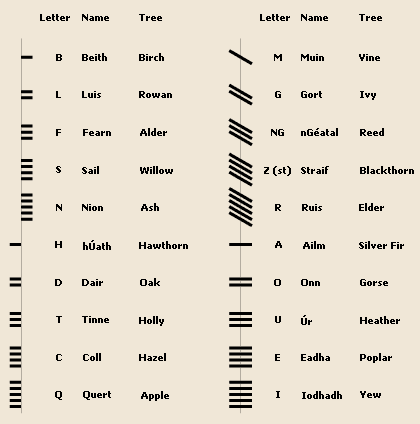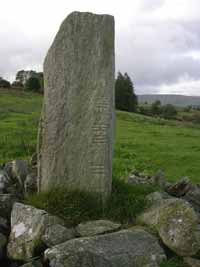|
Ogham AlphabetThe Celtic Ogham alphabet perfectly fits in the mystical Celtic culture. Due to its uniqueness it is tempting to adopt the Celtic belief that was a gift directly from the Tuatha de Danaan God Ogimos, also known as Ogma, the God of Eloquence.
The Ogham alphabet The origin of Ogham is a complete mystery. It is even unclear when and where people started to use it. Julius Caesar, who lived in the first century BCE, mentioned druids using Ogham in Gaul, modern day France, but scientists can not find any Ogham carvings prior to 300 or 500 CE. This time-gap is mysterious, but even more mysterious is that there are no known examples of Ogham in France. Enough riddles for now. What do we know about the Ogham alphabet and the people using it? Initially the Ogham alphabet consists of twenty characters. Later some additional and more complex characters were added. The characters were named after trees or plants and were specifically designed for carvings in stone and wood. The centreline in the adjoining figure was the edge of the piece of wood or the stone. In general the writings were read from bottom to top or, in some rare occasions, from right to left. Although some people think there was something as a táball-lorg, or poets staff, there is no evidence or even an indication that Ogham was used for poetry or for divination or magical purposes. In contrary, beside the observation of Julius Caesar there is no shred of evidence that Ogham was ever used by druids or bards. Caesar himself provided us with two reasons why the druids had an aversion against writing. Firstly sharing their knowledge would jeopardize their high standing and lifestyle. After all, druids were no magicians in the meaning of wizards, they were just highly educated and intelligent men. Secondly they were afraid that they would lost their remarkable ability to remember. The origin of Ogham
Aghascrebagh Ogham Stone, There are several theories about the origins of Ogham. Some of them are far-fetched while others do not match with what we know about Ogham. Although geographical far apart the Greek alphabet is considered a serious candidate. It is known that there has been an active trade between the Irish Celts and the Greek, which also involved an exchange of philosophies and ideas. Further if you take a close look at the Ogham notches the look like furrows and there are examples that the Greek compared writing in general with ploughing a field. By the way, the Greek word for furrow is ogmos. This theory is also supported by the fact that some of the characters are associated with trees that does exists in Central Europe, but not on the British Isles. It is seemingly pretty safe to presume that the Celts used the Greek alphabet, from which the Ogham alphabet derived its name, as an example to develop the Ogham characters at an early stage somewhere in Central Europe and that they brought it to Gaul, where it was noticed by Julius Caesar, and eventually to the British Isles. Tantalising question is why there are no examples of Ogham found on the European mainland, except from some isolated occurrences? Did this mystique script inspire that much fear in the Romans that they started a highly effective witch hunt as a result of which all Ogham examples were destroyed? Although there is no evidence for this theory it does explain why Ogham inscriptions are found in areas unaffected by Roman influence. Under the influence of Christianity the use of Ogham, which was considered a pagan legacy, slowly fell into disuse. Thanks to the fourteenth century Book of Ballymote, which is considered the Rosetta Stone of Ogham, and Ogham stones, such as Aghascrebagh in the Creggan, scientists were able to translate Ogham.
Every thought is a whispered prayer.
|
|
|---|














